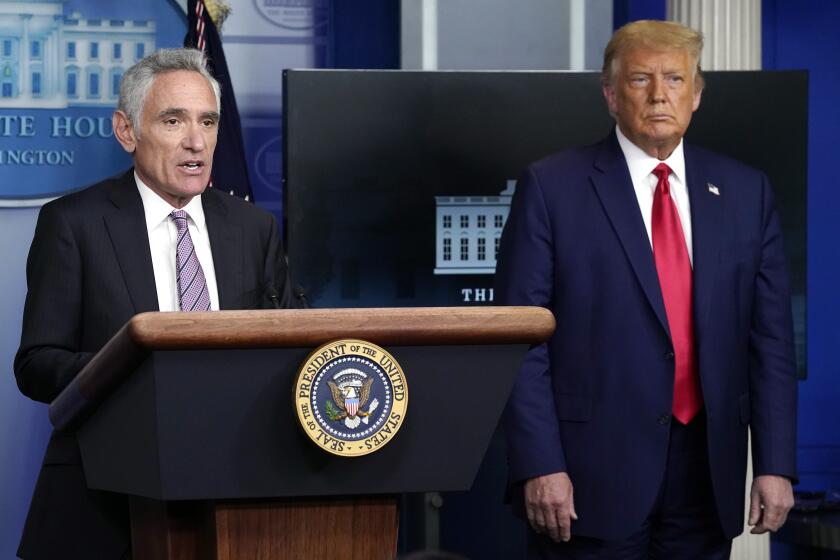Responding to the Mother of All Invention
Market share and profits can be wonderful incentives, but nothing spurs high-speed innovation quite like death. So after 10 Americans were killed by “friendly fire” during nighttime Desert Storm operations in February, the Pentagon immediately recognized that accidental fratricide posed as great a threat to allied soldiers as any poison gas.
Instead of tossing the problem into the maw of its massive bureaucracy or simply dismissing such deaths as “just one of those things that happen in war,” the Pentagon chose to respond with uncharacteristic speed and nimbleness: A new nighttime “anti-fratricide identification device” was designed, prototyped, tested, built, shipped and deployed in 20 days. It even worked.
Now that all the parades are over, it’s time to ask if this kind of turnaround is going to become the exception or the rule in military innovation. This AFID episode provides both a provocative behind-the-scenes view of how to manage innovation and a sharp rebuke to the leisurely, inertia-driven procurement practices that now dominate Pentagon procedures. There are even a few lessons here for civilian high-tech companies.
Appalled by CNN reports of the “friendly fire casualties,” Robert Walleston, an engineering technician at a small defense-oriented New Hampshire electronics job shop, sketched out an idea to build a battery-powered infrared “beacon” that could be easily spotted by combat pilots peering through their night-vision goggles.
By attaching these beacons to ground vehicles, the United States would preserve its nighttime advantage and minimize the chances of an inadvertent air strike.
“We have absolutely no bureaucracy,” says Rance Walleston, Robert’s brother and the director of business development at Test System Inc. “So we decided to put one together. We figured that somebody must have thought of this already, but we heard that nothing had actually been fielded.”
At roughly the same time that Test Systems began building its first prototype, Air Force Lt. Gen. Michael P. C. Carns, director of support for the Joint Chiefs of Staff, had turned to the Pentagon’s Defense Advanced Research Projects Agency to come up with some sort of anti-fratricide device as quickly as possible.
DARPA, which has a reputation for funding futuristic state-of-the-art technologies, had to focus on innovating within very tight constraints. Through a fortuitous exchange of faxes, the Test Systems prototype came to the attention of Col. Doc Dougherty, the technical assistant to DARPA’s director. He called Test Systems on Thursday, Feb. 7, and asked them to send over a prototype by the next day. The New Hampshire firm, which has a number of defense industry alumni and specializes in custom electronic projects, delivered.
Dougherty was impressed with the turnaround and asked for several modifications. For example, the batteries weren’t designed properly and the infrared light-emitting diode (purchased from a local Radio Shack) just wasn’t powerful enough. After working though the weekend, TSI delivered the second prototype by hand that Monday.
That prototype was shipped to Hurlburt Field in Florida for testing. It did fine and DARPA ordered 10 more prototypes and awarded TSI a $3.2-million contract to produce 10,000 units if the box could perform. Col. Dougherty flew out to New Hampshire to work on site with TSI on the engineering design of the AFID and coordinate the information flow within the military bureaucracy.
“DARPA was fantastic,” says TSI’s Walleston. “Col. Dougherty spent the whole engineering design phase here--from the 13th to the 20th--and he was hollering out design changes and suggestions to us while he was getting information from people on the phone.” Over four days, a team of engineers and technicians from DARPA, TSI and the Army’s Night Vision Laboratory from Ft. Belvoir, Va., created no fewer than seven prototypes. Design changes went from conference room to machine shop in a matter of minutes. More than 100 significant alterations were built into the boxes. A more powerful infrared diode from a California company was discovered and procured.
The product had to be simple and easy to use. Just push a button and forget about it. But there were complications. For example, because you can’t see infrared with the naked eye, there had to be some way to make sure the diodes were working. Ultimately, the design used seven standard C cell batteries to power four diodes to blink in sequences that night-visioned pilots could easily spot. On Feb. 21, the TSI final prototype won a “shootout” against 21 other AFID prototypes in Yuma, Ariz.
“We had the right package, the right diodes at the right time,” says TSI’s Walleston. Actually, the real key was that TSI had become part of a tight fabric of suppliers and customers that enabled them to create a product that was intimately designed to get the job done.
By building multiple prototypes, the team didn’t just test ideas--they tested practical applications. The prototype became the most important tool in the development process. Built almost solely from off-the-shelf parts, the first TSI AFIDs were shipped on Feb. 25--two days before the end of the war. A few actually made it to vehicles in the Gulf. From concept to Kuwait City in less than three weeks.
There’s no question that the Pentagon is far more serious about using technology to minimize the “friendly fire” problem than before. What’s more, there’s no question that this sort of process could shrink procurement times from years to months in other critical systems.
But, warns one Pentagon official, “the bureaucracy is back in control.” It shouldn’t require a war to get the Pentagon to accelerate, compress and more intelligently manage its procurement processes.
The lessons here are simple and significant: Indeed, DARPA actually submitted a “Lessons Learned” from this AFID experience and other so-called “Rapid Acquisition in Response to Crisis.” Use off-the-shelf equipment that can be rapidly procured. Get customer input early and often--and make sure you pick the right customer. Build prototypes that are tailored to exploit the unique characteristics of the problem--as opposed to providing comprehensive solutions that “solve” all problems. Build a developer/user/service/industry team. Use “trial and success” methodology--keep what works; throw out and rebuild everything else. It’s not enough to build big budget platforms such as B-2s and Tridents.
There’s always a need for flexible and innovative technical response to unanticipated situations. Both the defense and non-defense industries need to do a much better job of building the structures and processes that generate flexible response.
More to Read
Inside the business of entertainment
The Wide Shot brings you news, analysis and insights on everything from streaming wars to production — and what it all means for the future.
You may occasionally receive promotional content from the Los Angeles Times.










